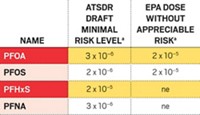Advertisement
Grab your lab coat. Let's get started
Welcome!
Welcome!
Create an account below to get 6 C&EN articles per month, receive newsletters and more - all free.
It seems this is your first time logging in online. Please enter the following information to continue.
As an ACS member you automatically get access to this site. All we need is few more details to create your reading experience.
Not you? Sign in with a different account.
Not you? Sign in with a different account.
ERROR 1
ERROR 1
ERROR 2
ERROR 2
ERROR 2
ERROR 2
ERROR 2
Password and Confirm password must match.
If you have an ACS member number, please enter it here so we can link this account to your membership. (optional)
ERROR 2
ACS values your privacy. By submitting your information, you are gaining access to C&EN and subscribing to our weekly newsletter. We use the information you provide to make your reading experience better, and we will never sell your data to third party members.
Environment
Levels Of Bisphenol A In U.S. Population Drops
by Britt E. Erickson
October 8, 2012
| A version of this story appeared in
Volume 90, Issue 41
The Centers for Disease Control & Prevention has added new biomonitoring data to its “Fourth National Report on Human Exposure to Environmental Chemicals.” The information includes updated levels for 119 chemicals, as well as concentrations of 34 substances analyzed for the first time in a representative sample of the U.S. population. The updated data show that levels of the estrogenic plastics chemical bisphenol A and many perfluorinated compounds have decreased in Americans since 1999. Levels of cotinine, a metabolite of nicotine, have declined in nonsmokers, and levels of the gasoline additive methyl tert-butyl ether have also fallen since 1999. On the other hand, levels of perchlorate, a compound used in rocket fuel, have generally increased in the U.S. population. The trends for other chemicals—including endocrine-disrupting phthalates and metabolites of organophosphorus pesticides—are more complex, with the concentrations of some substances increasing and some decreasing. The updated data are based on blood and urine samples collected from more than 2,000 people who participated in CDC’s National Health & Nutrition Examination Survey in one or more of the periods 2005–06, 2007–08, and 2009–10.





Join the conversation
Contact the reporter
Submit a Letter to the Editor for publication
Engage with us on Twitter